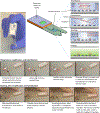Lab-on-a-Film disposable for genotyping multidrug-resistant Mycobacterium tuberculosis from sputum extracts
- PMID: 30801596
- PMCID: PMC6461559
- DOI: 10.1039/c8lc01404c
Lab-on-a-Film disposable for genotyping multidrug-resistant Mycobacterium tuberculosis from sputum extracts
Abstract
We describe a Lab-on-a-Film disposable that detects multidrug-resistant tuberculosis (MDR-TB) from sputum extracts. The Lab-on-a-Film disposable consists of 203 gel elements that include DNA sequences (probes) for 37 mutations, deletions, or insertion elements across 5 genes (including an internal control). These gel elements are printed on a flexible film, which costs approximately 500 times less than microarray glass. The film with printed gel elements is then laminated to additional rollable materials (films) to form a microfluidic flow cell. We combined multiplex amplification and hybridization steps in a single microfluidic chamber, without buffer exchanges or other manipulations up to and throughout hybridization. This flow cell also incorporates post hybridization wash steps while retaining an entirely closed-amplicon system, thus minimizing the potential for sample or amplicon cross-contamination. We report analytical sensitivity of 32 cfu mL-1 across all MDR-TB markers and detection of MDR-TB positive clinical specimens using an automated TruTip workstation for extraction and the Lab-on-a-Film disposable for amplification and detection of the extracts.
Conflict of interest statement
Conflicts of interest
All Akonni-affiliated authors are employees of Akonni Biosystems Inc. AK, AP, CK, YL, DPC and CGC are also Akonni shareholders.
Figures



Similar articles
-
Genotyping Multidrug-Resistant Mycobacterium tuberculosis from Primary Sputum and Decontaminated Sediment with an Integrated Microfluidic Amplification Microarray Test.J Clin Microbiol. 2018 Feb 22;56(3):e01652-17. doi: 10.1128/JCM.01652-17. Print 2018 Mar. J Clin Microbiol. 2018. PMID: 29305543 Free PMC article.
-
A Benchtop Automated Sputum-to-Genotype System Using a Lab-on-a-Film Assembly for Detection of Multidrug-Resistant Mycobacterium tuberculosis.Anal Chem. 2020 Apr 7;92(7):5311-5318. doi: 10.1021/acs.analchem.9b05853. Epub 2020 Mar 24. Anal Chem. 2020. PMID: 32142258 Free PMC article.
-
Evaluation of efficiency of nested multiplex allele-specific PCR assay for detection of multidrug resistant tuberculosis directly from sputum samples.Lett Appl Microbiol. 2016 May;62(5):411-8. doi: 10.1111/lam.12564. Lett Appl Microbiol. 2016. PMID: 26972777
-
Comparative evaluation of GenoType MTBDRplus line probe assay with solid culture method in early diagnosis of multidrug resistant tuberculosis (MDR-TB) at a tertiary care centre in India.PLoS One. 2013 Sep 5;8(9):e72036. doi: 10.1371/journal.pone.0072036. eCollection 2013. PLoS One. 2013. PMID: 24039735 Free PMC article.
-
Feasibility of a new model for early detection of patients with multidrug-resistant tuberculosis in a developed setting of eastern China.Trop Med Int Health. 2017 Oct;22(10):1328-1333. doi: 10.1111/tmi.12934. Epub 2017 Sep 18. Trop Med Int Health. 2017. PMID: 28746979
Cited by
-
Clinical Evaluation of the XDR-LFC Assay for the Molecular Detection of Isoniazid, Rifampin, Fluoroquinolone, Kanamycin, Capreomycin, and Amikacin Drug Resistance in a Prospective Cohort.J Clin Microbiol. 2023 Mar 23;61(3):e0147822. doi: 10.1128/jcm.01478-22. Epub 2023 Feb 9. J Clin Microbiol. 2023. PMID: 36757183 Free PMC article.
-
Nose-on-Chip Nanobiosensors for Early Detection of Lung Cancer Breath Biomarkers.ACS Sens. 2024 Sep 27;9(9):4469-4494. doi: 10.1021/acssensors.4c01524. Epub 2024 Sep 9. ACS Sens. 2024. PMID: 39248694 Free PMC article. Review.
-
Laboratory Evaluation of a Lateral-Flow Cell for Molecular Detection of First-Line and Second-Line Antituberculosis Drug Resistance.J Clin Microbiol. 2020 Oct 21;58(11):e01417-20. doi: 10.1128/JCM.01417-20. Print 2020 Oct 21. J Clin Microbiol. 2020. PMID: 32817085 Free PMC article.
-
Detection of Mycobacterium tuberculosis in pediatric stool samples using TruTip technology.BMC Infect Dis. 2019 Jun 27;19(1):563. doi: 10.1186/s12879-019-4188-8. BMC Infect Dis. 2019. PMID: 31248383 Free PMC article.
-
Point-of-care diagnostics for infectious diseases: From methods to devices.Nano Today. 2021 Apr;37:101092. doi: 10.1016/j.nantod.2021.101092. Epub 2021 Feb 6. Nano Today. 2021. PMID: 33584847 Free PMC article. Review.
References
-
- World Health Organization, Global tuberculosis report, 2018.
-
- World Health Organization, Global tuberculosis report, 2016.
-
- World Health Organization, High priority target product profiles for new tuberculosis diagnostics: report of a consensus meeting, 2014.
-
- Pantoja A, Kik S, and Denkinger C, J. Infect. Dis, 2015, 211, S67–S77. - PubMed
Publication types
MeSH terms
Grants and funding
LinkOut - more resources
Full Text Sources
Other Literature Sources
Miscellaneous

